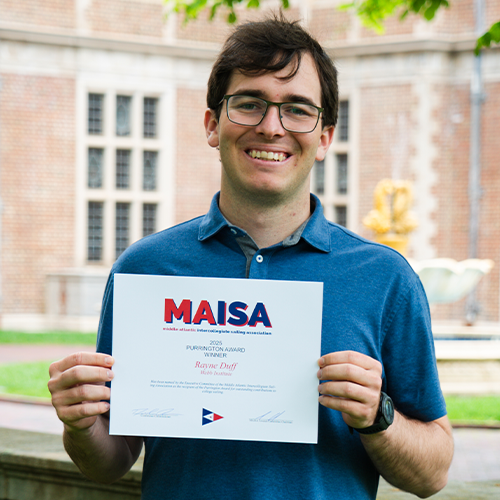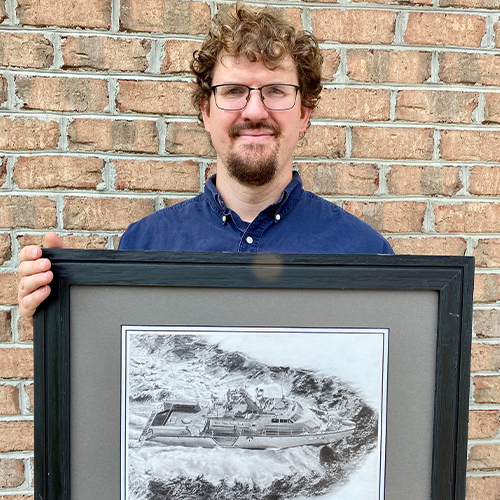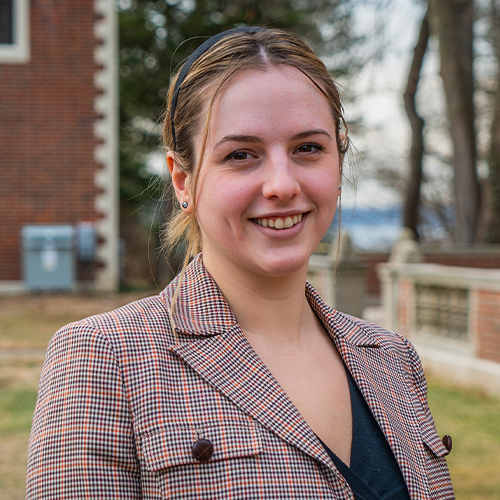Applying Webb’s Engineering Foundations to Composite Yacht Design at MPYD
By Thomas Motyka ’25
One of my earliest childhood memories is of my dad’s 1969 Correct Craft Mustang, a fiberglass ski boat powered by a Ford 302 V8. With its low freeboard and sleek lines, I thought it was the coolest thing in the world. Truthfully, it was a bit of a clunker with most outings ending with a tow back to the dock. Despite the endless mechanical issues, I was hooked immediately. My passion for recreational boats started at a young age, and I have been fortunate to pursue that interest in my time at Webb.
I spent the winter work term of my senior year as a Naval Architecture Intern at Michael Peters Yacht Design, spending much of my time on structural design and calculations. My biggest project was developing fiberglass laminate schedules and stiffener layups for the deck of a 46-foot express cruiser, the Eclipse 455. This process allowed me to take a lap of the structural design spiral, including weight studies, construction drawings and hydrostatic checks.
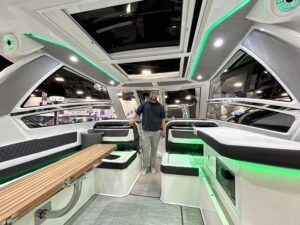 In my time with MPYD I was fortunate to go on a variety of field trips around southern Florida. In my second week of work, a group of us went to check in on the construction of Tribute Custom Boat’s latest build, a 62-foot sportfish. When I visited the hull was just about done, and the crew was landing the lifting strakes on the running surface. On the same trip we attended an open house hosted by Kady-Krogen to see the MPYD designed Summit 54. I got the chance to walk this boat with MPYD’s Senior Designer and Creative Director, where he talked me through many of the challenges they encountered over the course of the design.
In my time with MPYD I was fortunate to go on a variety of field trips around southern Florida. In my second week of work, a group of us went to check in on the construction of Tribute Custom Boat’s latest build, a 62-foot sportfish. When I visited the hull was just about done, and the crew was landing the lifting strakes on the running surface. On the same trip we attended an open house hosted by Kady-Krogen to see the MPYD designed Summit 54. I got the chance to walk this boat with MPYD’s Senior Designer and Creative Director, where he talked me through many of the challenges they encountered over the course of the design.
Later in my internship we travelled to the Miami International Boat Show, where we got to see many of MPYD’s past designs, and do recon for upcoming projects. I got the chance to get aboard the Eclipse 505, the big brother to the 455 which I spent most of my internship working on. As a fun aside, I also got to see the newly debuted Cobalt R35C. I worked on this boat extensively during my junior year internship with Bill Prince Yacht Design.
As a senior I felt prepared for this internship, and I am very grateful for the opportunities I have had in my time at Webb. The Webb curriculum is rooted in building sound engineering principles and then applying them to the marine industry. These practical applications are primarily related to the commercial shipping industry, so it was very cool to apply these engineering principles to the recreational industry. One of the most notable differences between these two sectors of the industry are the materials of choice. Most commercial vessels are made from metal, while most recreational vessels are made from composite materials. Webb’s material science and strength of material courses both address composite materials, but the brunt of the coursework is centered around steel. I developed an interest in composite structures during my junior year at Webb, and this internship with MPYD allowed me to do a deep dive into composites.
In my time at MPYD I also spent some time working with Michael Peters developing a lines plan for a 35-foot sportfish hull. Once again, this allowed me to take the concepts I learned at Webb and expand upon them. While the Webb curriculum mostly addresses the design of slower speed displacement hulls, I got the chance to draw a set of lines for a high-speed planing hull.
I am incredibly grateful to the team at MPYD for being so welcoming, and for teaching me so much in my short time there. I would like to extend a special thank you to Oscar Como ’21 and Robert Maes ’21 for taking me in and showing me around the Sarasota area.
This was my sixth internship in my time at Webb, and as I reflect on my experiences, the biggest piece of advice I can give for students entering internships is to fully commit to being involved. I went to five of my six internships alone, and while challenging at first, this forced me to get comfortable outside of the support network that I found in my classmates at Webb. Jump on every opportunity that you can, make friends with your coworkers, and force yourself to push the limits of your comfort zone.
Charting a New Course: Rayne Duff ’25 on Leadership, Legacy, and Lifting Webb Sailing to National Recognition
Meet Rayne Duff ’25, this year’s recipient of the MAISA (Middle Atlantic Intercollegiate Sailing Association) Student Leadership Award, a rare and remarkable honor for someone representing a small, fully student-run team like Webb Sailing. The award, one of the most prestigious recognitions in college sailing, goes beyond performance on the water. It honors leadership, sportsmanship, and meaningful contributions to the sport.
When Rayne heard his name announced at the college sailing awards ceremony, he was stunned. Representing a small, student-run team from Webb Institute, Rayne had never expected to receive recognition on such a stage. But his leadership, dedication, and commitment to growing Webb Sailing stood out. Under his leadership, Webb Sailing has grown from a modest club into a nationally competitive team, achieving milestones like cross-regional status and a Nationals appearance, all while balancing the rigorous academic demands of Webb.
In this Q&A, Rayne reflects on the journey, the challenges overcome, and the pride of building something lasting- not just for his team, but for future generations of Webbies.
1. What was your initial reaction when you found out you had been selected?
My first reaction was that I could not believe it. At the awards ceremony, we usually do not expect any Webbies to win awards. Our schedule does not allow us to participate in team racing, which is considered heavily in the awards. Although this award, which is related to uplifting college sailing in MAISA, technically does not require the sailor to team race, I was very surprised to hear my name when they announced it.
2. Can you explain what this award means to you personally, especially as someone representing a smaller school like Webb?
To me, this award really helps me realize that somebody noticed all the work that goes into helping a small team like Webb grow and become competitive. Almost all of the non-academic activities at Webb are student-run, including sailing. This brings a leadership role and large responsibility to many of us. Leadership at Webb is what gave me the responsibility to help the sailing team succeed. At the schools we are competing against, they often have multiple full-time coaches who manage the team. When we race against these teams and perform well, it shows the strength that student leadership gives to our community.
3. The award recognizes not just athletic skill, but leadership, sportsmanship, and contributions to the sport. What specific efforts or initiatives do you think stood out to the selection committee?
Looking back, it can be hard to say exactly what stood out to the selection committee. I can think of a few factors that could have contributed, so I will list them out here. The first option that comes to mind is the promotion of the Webb Sailing team to cross-regional status. Team status does not change very often, as it requires a significant change in the organization and performance of the team. Some other options that could have played a factor are consistent participation in MAISA meetings and regattas, helping promote MAISA sailing though raising the competition level at regattas, and helping Webb sailing in any way possible through the four years here. Another consideration that likely played a factor was that before 2022, Webb had not qualified for nationals since 1976. This marks a significant growth in performance for the team, and brings Webb to a wider audience on the College Sailing scene.
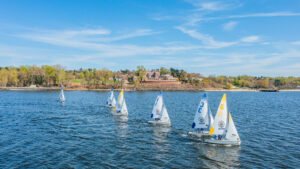 4. You mentioned helping bring Webb Sailing to the national level. What were some of the challenges you faced in doing that, and how did you overcome them?
4. You mentioned helping bring Webb Sailing to the national level. What were some of the challenges you faced in doing that, and how did you overcome them?
To answer this question, I have to mention Payne Donaldson and Kenna Reed from the class of 2024. They revitalized Webb sailing after COVID, and helped inspire me to sail my best at every event. Their strong performance was one of the most important factors that brought us to qualifying for College Sailing Nationals in 2022. That performance was what helped our team overcome one of the most important challenges during my time at Webb: upgrading the team to cross-regional status. Cross-regional status allows Webb sailing to participate in competitive regattas against schools from other conferences during the normal sailing season. This is an amazing privilege that is only earned through good organization, communication, and performance for several seasons in a row.
5. How did you balance your academic workload at Webb with the time and energy needed to grow and support the sailing team?
Fully committing to College Sailing at Webb requires some sacrifices in either academics, sleep, or social life. During peak sailing season, particularly in the fall, there is a regatta every weekend. This means all assignments need to be done during the week. It also means that on Friday night when our classmates are celebrating the weekend, the sailing team begins another long drive to the next regatta to represent our school. All the team members choose sailing every weekend they can, highlighting the commitment of this team.
6. How has being part of the MAISA (Middle Atlantic Intercollegiate Sailing Association) and the larger ICSA (Inter-collegiate Sailing Association) community shaped your college experience?
One of the most rewarding aspects of participating in sailing through MAISA has been seeing old and new friends at regattas week after week. Many of the regattas we attend are with the same schools, so getting to see friends from high school who now go to those schools is a unique and special experience in College Sailing. Also, the teams near us, like SUNY and Kings Point, have been amazing supportive friends to Webb, often offering their boats to us so we can practice together. The friendship and camaraderie from those experiences is unforgettable.
7. What advice would you give to future Webb students who want to get involved in competitive sailing or help grow a program further?
My advice would simply be to go sailing! Every regatta we are looking for more people to participate. Even if you have never sailed before, the team is always happy to coach each other and bring everyone up to speed. My best example of this is Kadi Zheng ’24, who had not sailed much before Webb. By her senior year, she was one of the best sailors on the team and competed against the top crews in the country. She did this by consistently showing up to race, even when it was inconvenient for academics. I see a lot of sailors start at Webb with some sailing experience and want to get involved with racing, but sometimes the school work makes it difficult to commit the time required. Focusing on time management early every week will pave the way to racing and representing Webb on the weekends.
8. This award also nominates you for the James Rousmaniere Award at the national level. What does that broader recognition mean to you and the team?
Nomination for this award alone is an honor. Every team captain at Webb in recent years contributed to bring Webb Sailing to where it is today, and we would all feel proud to be recognized on a national level.
9. Looking back, what moment or achievement are you most proud of from your time with Webb Sailing?
What made me the most proud in my time here was the week leading up to the National Championship of 2023. That particular year, Nationals were hosted at Kings Point, which meant that we did not need to pay for housing away from Webb. This left enough money in the budget to hire a coach, Sophia Reineke, for a small training clinic before the event as well as coaching during Nationals itself. This training clinic is what made me so proud to be contributing to Webb sailing. We managed to scrape together enough sailors to get all eight 420s out on the water for several days in a row. Even people who knew they would not race at the regatta still came out to practice to help their teammates prepare for the event. Watching us come together behind a common goal for that particular event made me proud to be a Webbie, and I still look back on it as the highlight of sailing at Webb over the past four years.
10. What’s next for you after graduation — will sailing continue to play a role in your life?
I could never imagine my life without sailing. I plan on moving to Seattle after graduation to work at Elliott Bay Design Group as a naval architect, and I already have plans to participate in several sailing groups in the area. Sailing at Webb gave me a new perspective on racing that will help me to enjoy the sport for many years to come, and I hope that many Webbies have the opportunity to experience the same in the future.
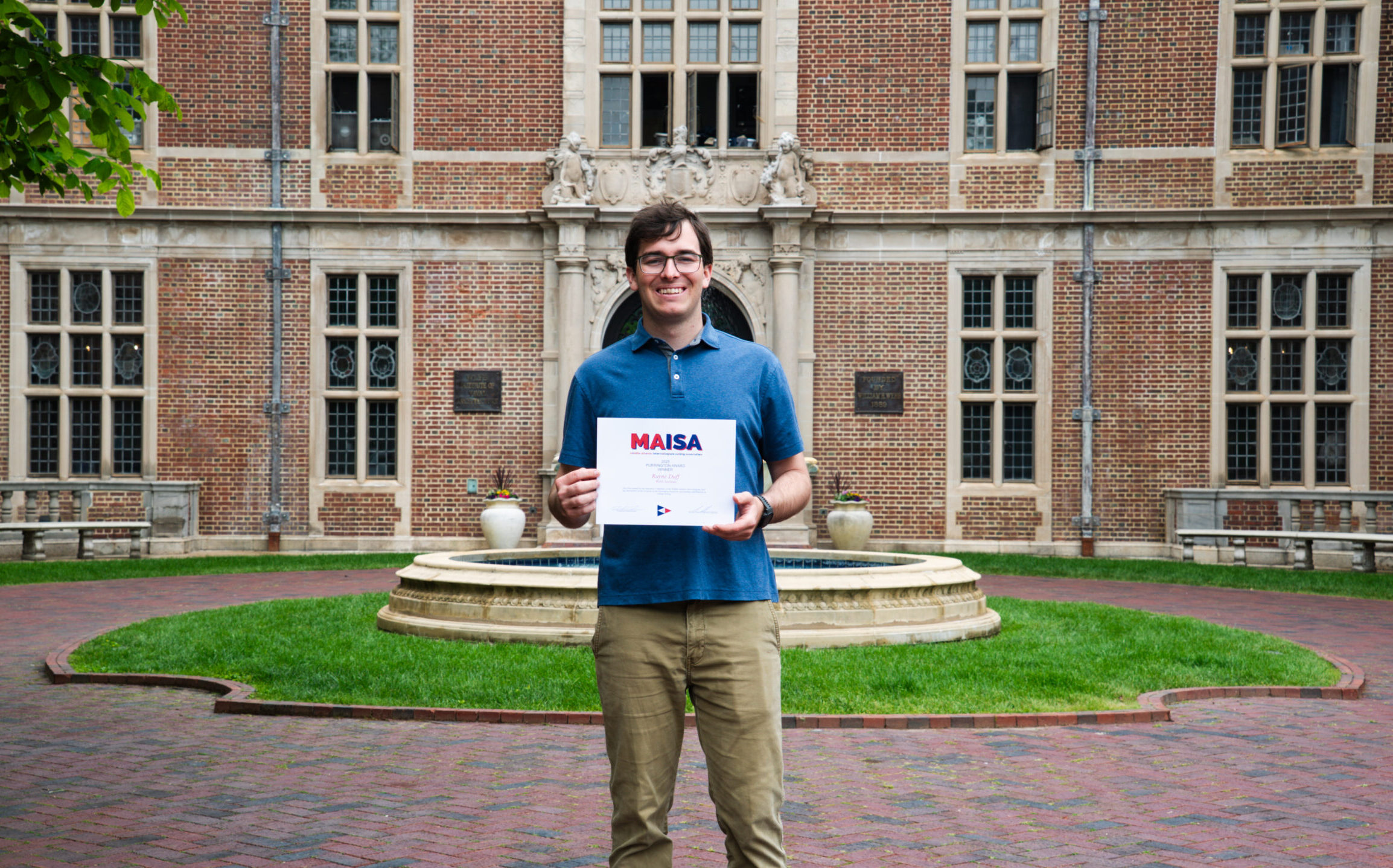
Life at Sea: What they don’t tell you about life on an oil tanker
By Spencer Rankin ’27
I wake up with a jolt to see our car stopping at security gates. At about 10 at night, it’s dark and rainy out. An armed guard meets us, asking us for our ID’s and to open our bags. It’s actually happening now, I realize. I’m about to join the oil tanker I’ll be interning on for the next fifty days.
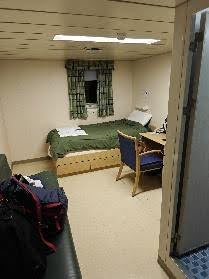
Home sweet home.
I’ve spent the last three hours in a port agent’s car driving north of Seattle to a BP refinery and port. Sitting across from me is the ship’s first assistant engineer, my direct supervisor for the next two months. Yikes. Trying my best to make conversation, I immediately stereotype him as someone who must love to hunt because he’s from Maine. Luckily, he does. I decided to leave the conversation at that and end up dozing off.
Finished scanning our IDs, the guard comes back to search our bags. He looks at mine and asks me to remove the jacket that’s folded on top. “I’m not actually allowed to touch your stuff,” he explains. So much for American security.
A new car arrives to drive us down the one-lane pier to the ship. “No phones out here,” the 1st mutters to me. They’re deemed an explosion risk around the transfer of fuel, occurring at 7,000 m3 / hour.
We climb the gangway to the ship and John shows me to my room. Home sweet home. Having just completed a 17-hour travel day, I’m tired enough to fall dead asleep. Yet, I can’t. My room is lightly vibrating, and I’m not exactly sure where in the ship, let alone the world, I am. “What have I gotten myself into?” I wonder. All I know is I’m in for an adventure.
I quickly settle in. I’m an engine cadet, which means I spend my days in the engine room learning by working alongside the ship’s engineers. All of them went to college for four years and spent 360 days working as cadets (like me) to do this. They know their stuff, and it shows. I, on the other hand, am a bit like a pet baboon. Nice to have around, perhaps, but not particularly useful.
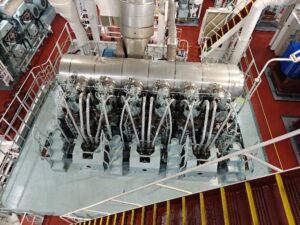
The 3-story tall low-speed diesel engine.
My first day of work I have the unforgettable experience of helping clean excrement off the toilet eductor – the component that makes our toilets flush like on an airplane, used because it’s water efficient. I gladly move on to more enjoyable activities, like servicing pumps and greasing motor gears. It’s humbling to realize just how little I know. Halfway into my stint an MAN technician comes aboard and we open a crankcase inspection door. It’s my first time seeing inside a working low speed diesel engine. These things are huge, three stories tall, and a marvel of engineering. It occurs to me that if not for this opportunity, I would have begun designing ships without really understanding how they work. How can someone possibly design an engine without ever seeing its insides?
Our ship loads refined petroleum in northern Washington, just a few miles south of the border, and brings it down to San Francisco and LA. 600 feet long, we can carry up to 340,000 barrels of oil, which at $2.50 a gallon equates to around $35M of cargo. For that responsibility, the ship’s crew is on charter for $100,000 a day. Most crew are on 75-day rotations – 75 days of work followed by 75 days of vacation. Some have shorter rotations. This is an industry that’s serious about getting the job done.
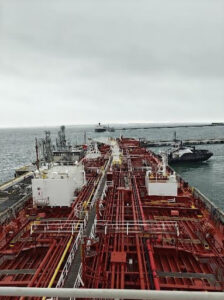
The ship can carry 340,000 barrels of oil at a time.
The days go by at sea, each one mostly like the last. You work, you eat, and you sleep, and that’s about it. About ten days in I lose track of what day of the week it is. It makes no difference, anyways. Having quickly finished the two books I packed and resort to reading the Financial Times. My conversation starters are becoming less interesting by the day.
You can spend months out here without ever interacting with half of the ship’s 20-odd crew. The deck, engine, and steward departments have minimal working interactions, which just leaves mealtimes to socialize amongst each other. When you are eating, the licensed officers and unlicensed crew have different mess halls. You end up learning everyone’s job title – 2nd mate, pumpman, captain, bosun, etc. – but often not their name. It’s weird.
The food is edible. Beyond that, you can’t expect much. Rice and fries have become a staple in my diet, for they are reliably all right. Vegetables are sparsely consumed. I occasionally dream of the day I can visit a café and splurge on a macchiato with a madeleine again. The coffee will be warm and textured with a punch of acidity, and the madeleine sweet with crisp edges and a lemon aroma. Realizing just how outrageous my fantasies are, I decide to keep these thoughts to myself.
I’m definitely not destined for a life out here. It’s exhausting. You are temporarily removed from modern society and all the benefits that come with it. But am I glad I’m doing this? Absolutely. It’s not every day you get the chance to experience working on a 600 foot oil tanker.
Link to my blog: https://medium.com/@spencer.rankin.00
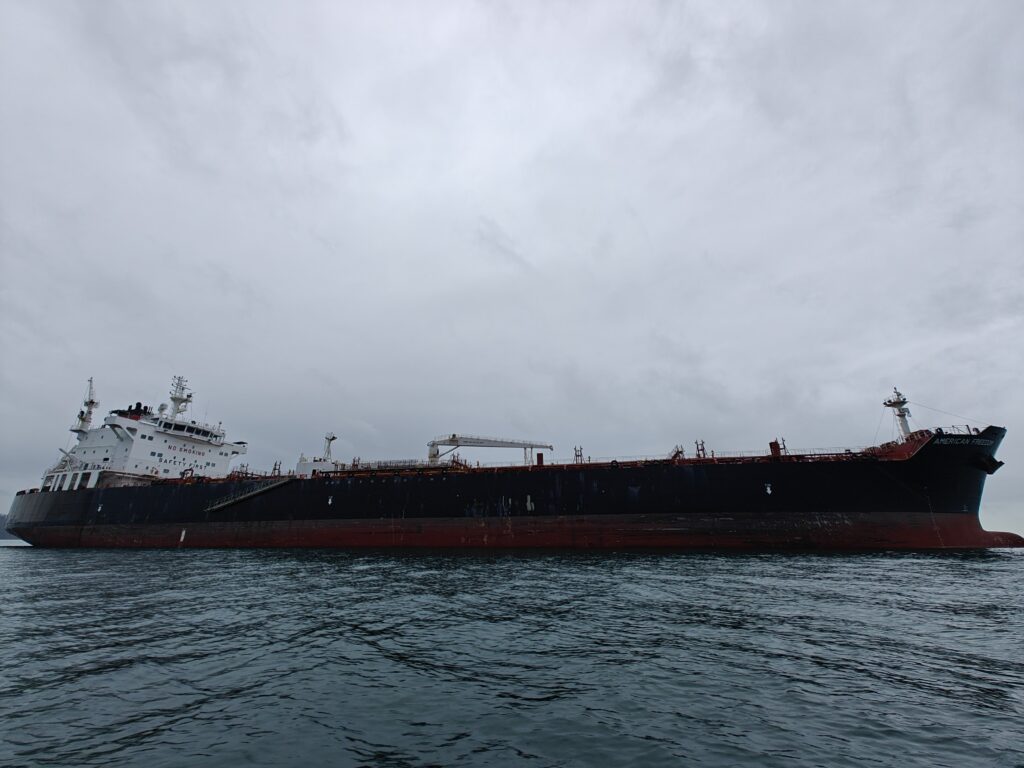
An impressive view of the 600ft oil tanker.
Alumni Spotlight: Ben Fisher ’11 | The Art of Shipbuilding
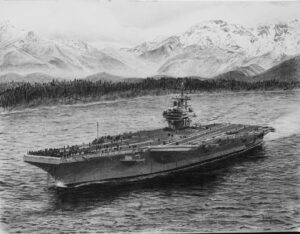 Growing up in rural Pennsylvania, the last thing I expected was to become a naval architect. But after seeing a Titanic documentary when I was four, I knew I was going to do something ship related. That initial encounter with Titanic sparked a love for ships (particularly with dramatic stories), as well as an obsession with drawing. So much so that by the time Middle School came to an end I struggled to identify any appealing career options, since as far as I knew “draw boats” wasn’t a real job.
Growing up in rural Pennsylvania, the last thing I expected was to become a naval architect. But after seeing a Titanic documentary when I was four, I knew I was going to do something ship related. That initial encounter with Titanic sparked a love for ships (particularly with dramatic stories), as well as an obsession with drawing. So much so that by the time Middle School came to an end I struggled to identify any appealing career options, since as far as I knew “draw boats” wasn’t a real job.
But by Divine Appointment the high school art teacher at my small, rural school in the mountains of Pennsylvania knew Professor Gallagher’s family. So, he introduced me to Webb and the career of Naval Architecture.
A great irony of my time at Webb, though, was the slow decline of the time I spent really drawing boats beyond notebook doodles. That trend continued as I began my career at SAFE Boats International (near Seattle) and as my wife and I began raising our family.
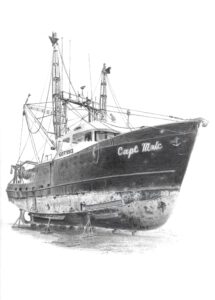
By early 2020, in the midst of COVID, we decided it was time to move back to the east coast in order to be closer to family and away from the dreary Seattle winters. I took a position with Combatant Craft Division, and we began developing our homestead in the country outside of Suffolk, VA with our five children. Through much of that time my drawing paper and pencils languished on the shelf.
It was only in late 2022, when the kids began sleeping better, that the inspiration to start drawing again struck me. I saw an old drawing from high school and wanted to try it again. That experience reignited my love of drawing, and I launched my art studio in June 2023.
As I have started sharing my artwork, one of the surprising results has been the joy I have found in honoring and celebrating the broad maritime history and heritage we love as naval architects, but also the very personal achievements we experience in our careers. The commissions I’ve had the privilege to draw (so far) have celebrated either a career or specific, meaningful project. And it is such an honor to contribute to that celebration through my artwork.
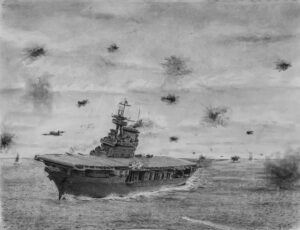 The excitement I’ve found has inspired the idea for a drawing that will celebrate the heritage of American naval architecture broadly. The idea is an image of William Webb’s Young America and William Francis Gibb’s United States crossing paths. The two very patriotically named ships were launched nearly 100 years apart, and both were the product of two incredibly significant naval architects in American maritime history. I am excited about this drawing because of how meaningful I think it will be to people with connections to naval architecture and who take pride in our maritime heritage.
The excitement I’ve found has inspired the idea for a drawing that will celebrate the heritage of American naval architecture broadly. The idea is an image of William Webb’s Young America and William Francis Gibb’s United States crossing paths. The two very patriotically named ships were launched nearly 100 years apart, and both were the product of two incredibly significant naval architects in American maritime history. I am excited about this drawing because of how meaningful I think it will be to people with connections to naval architecture and who take pride in our maritime heritage.
And so, as I am given the privilege of celebrating the achievements of my peers and our shared maritime history and heritage, I am incredibly grateful for the opportunity to make “draw boats” a real job after all.
If you’d like to follow my art journey, you can find my work in my online gallery at BenFisherArt.com.
I also post regularly on social media- I’m on LinkedIn: BenjaminDFisher, Facebook: BenFisherArt and Instagram: Naval_Art.chitect
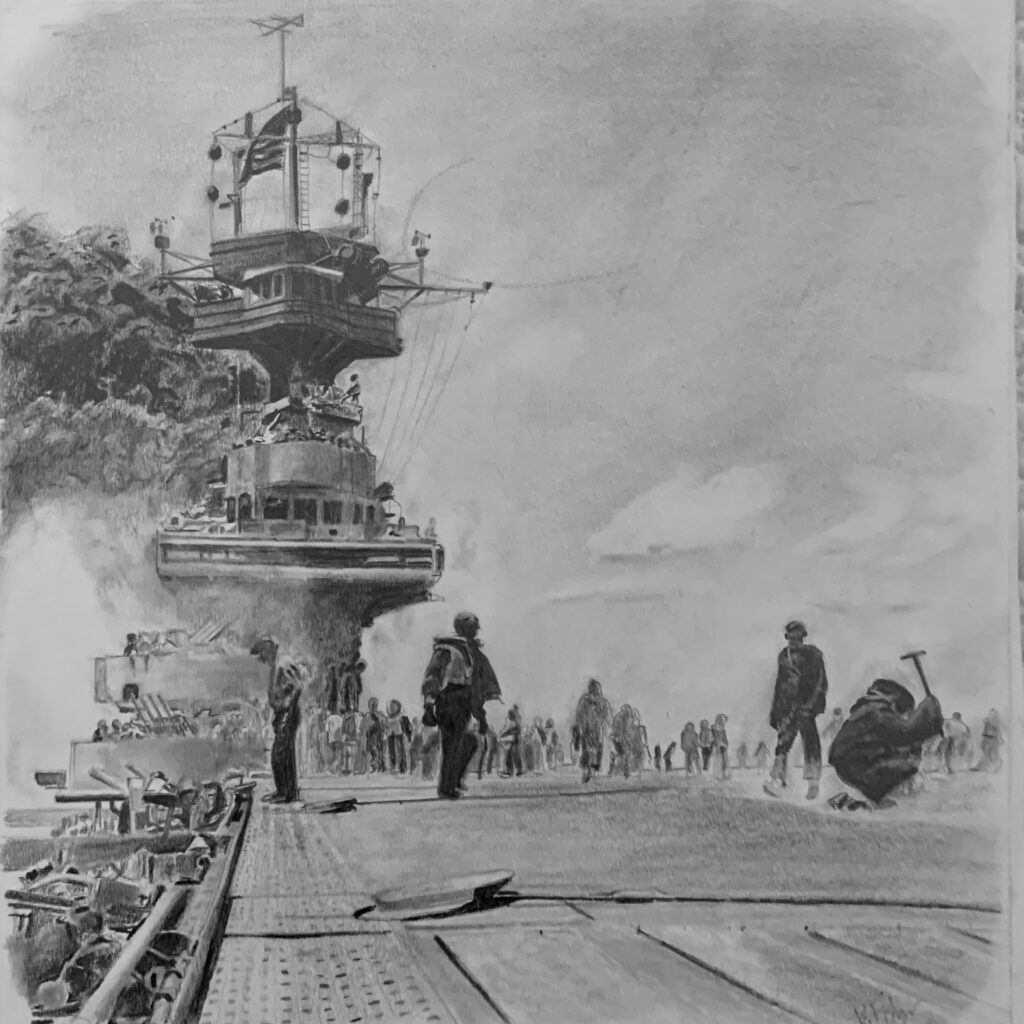
Webb Welcomes Natalie Koetsier as Assistant Director of Admissions
Hailing from Chicago, IL., Natalie Koetsier is an extraverted writer and Michigan native. Graduating from Loyola University Chicago with a BA in English creative writing and minor in advertising, Natalie values effective storytelling, clear communication, innovative thinking, and to never stop learning.
Previously, Natalie has held experiences as a copy editor for an award-winning newspaper and as a resident assistant. Most recently, Natalie worked on a social media team and as a sports writer covering the Detroit Lions, where her articles were the magazine’s top 3 most-viewed articles for the month of November.
Natalie is ecstatic to join Webb’s admissions team and connect prospective Webbies to this exceptional school. She has been around boats her whole life, and some of her favorite family memories are on the family boat in Spring Lake, MI. Natalie is also the proud big sister of Mitchell Koetsier, who is a part of the Webb Institute class of ‘28.
For 10 years, Natalie was a competitive gymnast who won the all-around and the balance beam national title. She still has some gymnastics tricks up her sleeve so do not challenge her to a dance off. For fun, she likes to go on walks, where she can admire water views and/or architecture.


